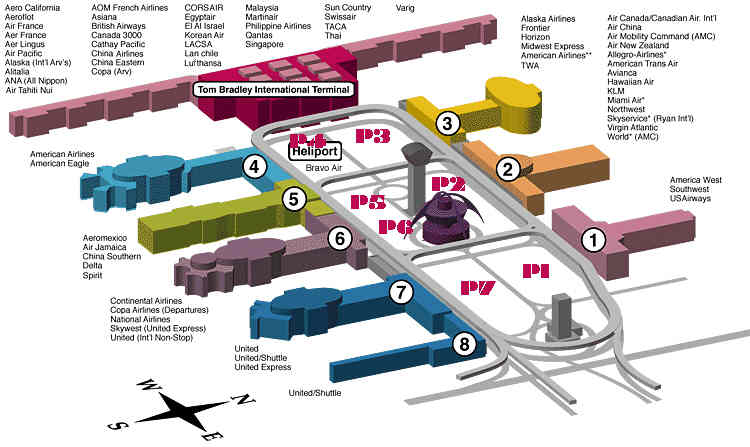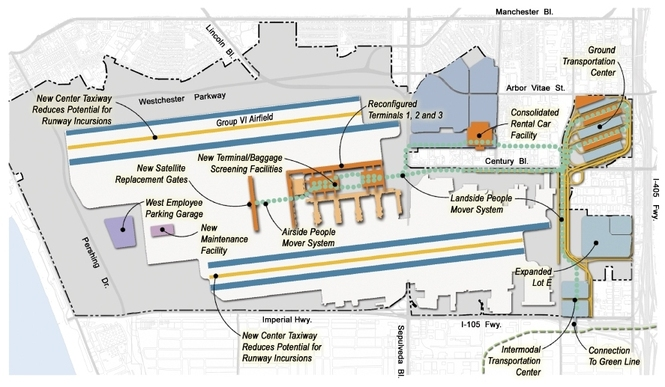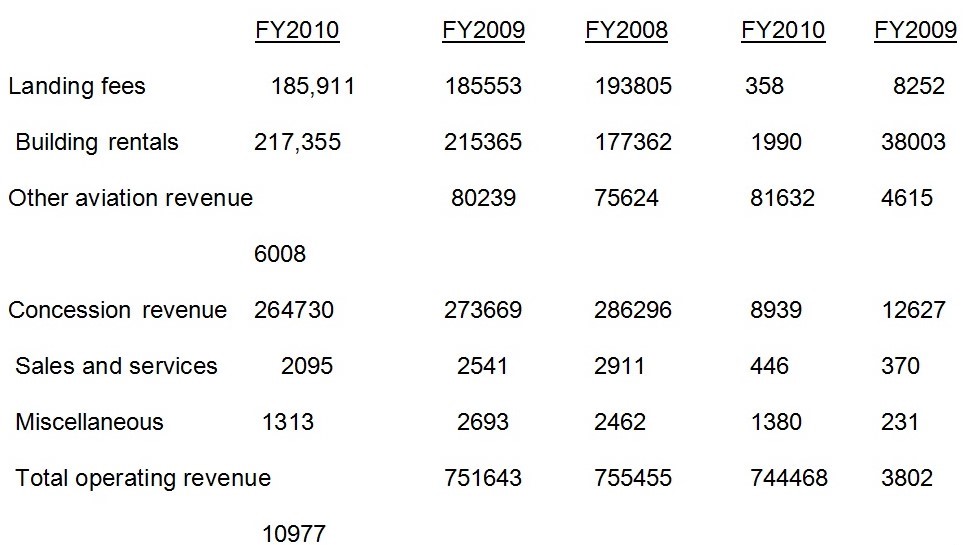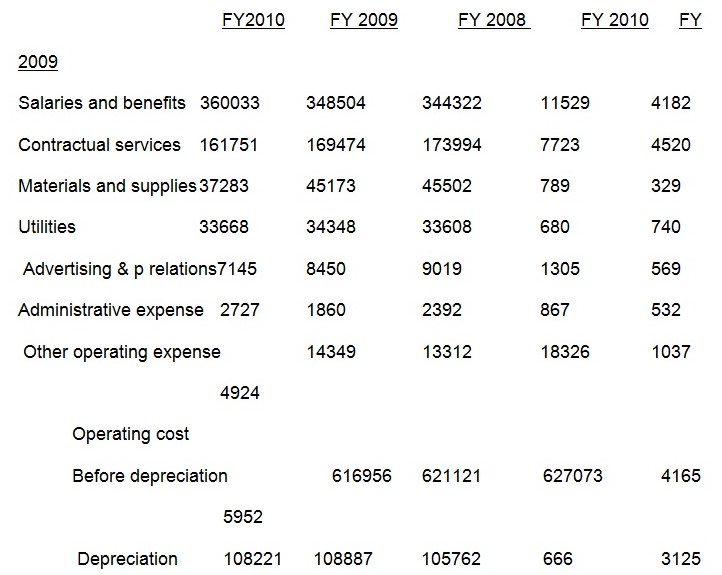Introduction
Los Angeles International Airport is the main airport which serves the greater Los Angeles Area. Los Angeles is the second most populated metropolitan area in the United States. The airport is usually referred by its IATA Code LAX. It is located in the South Western Los Angeles neighboring Westchester. It lies 16 miles (26km) from the down town core. It is the core airport of Los Angeles city government. By 2010, the airport was among the busiest airports in the world catering for approximately 58,915,100 passengers. By 2009, it was ranked fifth among the busiest airports on earth; at this time, it contained a traffic flow of 634,383 aircraft operations. The airport is categorized as a public airport in NPIAS. LAX also receives grants from AIP, which is approximated to be $ 1,297,473,026. It is the hub that accounts at least 1% of total US passenger emplacements (Philips, 2010).
Background Information
Los Angeles International Airport land was obtained in 1928. The first time airport structure was built was in 1929. However, the airport’s name got modified to Los Angeles International Airport in 1941. Currently, Los Angeles international airport is ranked among the largest and busiest airports in the world. In USA, it is the second largest airport serving more than 80 airlines. The airport is a major hub located in the west of the U.S. It covers 3.425 acres of land of the city lying on the pacific coast. The airport location makes it liable to low lying cloud cover or fog conditions causing the flights to be directed to LA/Ontario International Airport, which lies 47 Miles to the east (Philips, 2010).
Problem Statement
This research paper elucidates on the management of the Los Angeles Airport. It will excavate LAX history, airport Airside, airport land side, airport layout plan, Part 139 and compliance, airports security and risks and budget and finances. The paper will also look into the airport’s socioeconomic impact to the society and give recommendations where necessary.
Research Findings
From field study and findings, it is indicated that the contribution to the great performance of the airport is attributed to its great management. The Management of Los Angeles Airport is incredible and has seen to it that various innovative managerial coordination which increases the aggregate productivity and efficiency of the port improve drastically. From the surveys and research done on LAX it is evident enough that the management of the airport is the main reason for its success.
Among the factors that contribute to its success is the efficient bundle of products released by management that suit the needs of the customers; among these services include the Los Angeles Gift cards which encourage customers to airlines in the LAX. This gift card can be redeemed into other gifts of interest the customer or into flights to other destinations by the customer. Furthermore, the well endowed and highly specialized team of employees contributes to the success of the institution. These are well compensated to retain them within the organization since their efforts cannot be overemphasized. The modern form of technological advances has also seen the airport improve on its service offering. By offering a centralized customer based attention, it is possible for LAX to officiate their operations. All these factors are a contribution that is attributed to great management of LAX.
Airport History
Initially, the land on which the airport occupies was used for farming (growing cereals such as lima beans, barley, and wheat precisely). The land changed ownership numerous times. It was only in the 1920s when the pioneer aviators began to use the land as a makeshift airstrip. This made the community see the potential of the land and pushed to create a municipal airport (Airport Information, n.d.).
The International Airports location was originally a part of Mexican land called Rancho Sausal Redondo. The name was obtained from a clump of willows that existed along the coast which today is known as Playa Del Rey and Redondo Beach. The land extended to Inglewood. Originally, the land was owned by Juan Alvarado to Antonio Ygnacio, and later governor of Alta California in 1837. Through many years of leasing the land to several people, Bennet Rancho pioneered in using the land to attract aviator who made a landing strip. People started landing and departing at a rough ground. By 1927, the airport construction had been started by a group of local citizens. These people began to encourage for the establishment of the airport. By July, 640 acres of land were offered to real estate agent William W. Mines to be used as an airport for Los Angeles city. The land was known as the Mines field. In July, 1928, City council declared Mines Field as the Location city’s airport which became the Los Angeles International airport in October 1928 (Airport Information, n.d.).
The Los Angeles International Airport was officially launched as a commercial airline site in 1946. It was used as a general aviation field in 1928 during the Second World War. Today, Los Angeles international airport is ranked among the largest and busiest airports in the world. In USA, it is the second largest airport serving more than 80 airlines. The airport is a major hub located in the west of the U.S. It covers 3.425 acres of land of the city lying on the pacific coast. The airport’s location makes it liable to low lying cloud or fog conditions causing flights to be directed to LA/Ontario International Airport, which lies 47 Miles to the east. Los Angeles Airport caters for over 50 million passengers via its terminals annually. It handles over 1.8 million tons of freight and mails annually. It also plays a major impact in the California’s socio-economic sector. For instance, the airport provides one in every twenty jobs in Southern California (Airport Information, n.d.).
Airside Airport
The LAX is one of the major and busiest airports in the world. The airport enjoys good weather conditions. Regarding the airside facilities, the airport has two air traffic towers with taxiways connecting the runways to the terminals. It has two configurations depending on the wind directions. One is used for landings whilst the other for take offs. Lax can perform 137-148 under good weather conditions and 117-124 under instrument conditions (Leroyer, 2004).
The current configuration of LAX North Airfield Complex was completed in 1970s. Then, it was designed to efficiently accommodate FAA Design group III and IV. Currently, the fleet mix at LAX has drastically grown increasing the number of design group V and VI. It also has runaways 24L/06R and 24R/06L. Both runaways are 150ft wide with Runaway 24L/06R being 10285 ft long and Runaway 24r/06l being 8925 ft long. The run ways accommodate the fleet mix of aircraft using LAX (Anon, 2007).
Land Side Airport
Los Angeles International Airport is among the busiest airports in the U.S. Many passengers use multiple facilities at the airport land side. LAX tends to have tremendous capital improvement programs, including projects, which have been set up at Bradley West worth $1.5 Billion. The airport includes nine passenger’s terminals with U-shaped, public parking, and public transportation with many other facilities within the airport (Airport Information, n.d.).
The airport consists of two-level roadway; upper level is for baggage check-in and the lower floor for the baggage claims (Fig. 1). The airport has eight terminals meant for domestic flights. However, the big terminal only occupies the international flights. This terminal (B) is referred to as the Tom Bradley International terminal. More so, the airports host a variety of popular brand restaurants, cocktail lounges, gift shops, and quite huge duty free international flights. There are also many business centers which exist in the terminals for traveling public (LAWA, n.d.).

Additionally, the airport has approximately 8,000 parking spaces that spread around the terminals. It has more than 4,500 parking spaces in the parking lot C. The parking services are well organized to provide a number of shuttles to connect passengers to terminals with more ease. Currently, there is a huge on-going construction work on the landside of the airport. The airport aims at creating new concourses and seating areas in the nine terminals. They also aim at increasing their security screening at immigration and custom area. This improvement at the Landside plays an important role in the nation. It will also enable the airport to increase the number of passengers in the next five years. $4.11 billion capital project aimed at the improving of the land side management program is definitely a good sign for both LAX and the nation at large (LAWA, n.d.).
Some of the factors that potentially determine the layout of the landside of the airport include passenger/employee volume and facility spacing, terminal access spacing, political considerations, airport land use, indirect cost and other regional rail station proximity (Little, A.I.C.P & Gaffney, n.d.).
Airport layout plan
Los Angeles International Airport has set up a huge future development plan for the airport. The airport plan was first revisited since 1956 in May 2005. The management wanted to concentrate their airport master plan in taxiways, runways, terminal areas, airport’s entrances, passenger safety, and security. It took quite a while before the management could come up with the areas which needed to be improved. The airport master plan is divided into four plans namely airport safety, security, which will correlate with 21st century, ground transportation and job opportunities in Los Angeles County (Anon, 2008).

In the improvement of airport safety, the management is focusing in increasing the distance between the runways of LAX airport. For instance, 24L runway will be located 340ft way to the North. Consequently, there will be renovation of the airport’s terminals 1, 2, 3 and Tom Bradley International Terminal (TBIT). More so, it will widen the gates space. This way, TBIT will manage to handle a wide body of aircraft in the west side of the terminal in the future. More so, the planners will put a satellite concourse TBIT terminal to work operate to replace gates 1, 2 and 3 (Anon, 2008).
In the development of new measures for security in the 21st century, the airport management will develop Central Terminal Area (CTA) with the aim of enhancing security in the West employee parking structure to minimize the traffic issue. This way, it will provide safer ground transportation for all passengers who travel to and fro via LAX with convenience.
In the improvement of ground transportation, LAX will improve the transit connections by inter modal transportation center. This way, it will provide a direct connection to Metro Green Line. The airport will add the rental-car facility under Airport Rental Car operations. This idea which is part of the airport master plan for transportation aims at reducing traffic to improve passengers’ convenience by automated people mover which is going to connect GTC, RAC and ITC to the CTA. More so, the airport is dealing with unique system called flyway program, which offers clients a best handling of luggage and ticketing services at the airport (Anon, 2008).
This master plan will generate more jobs to the Los Angeles County. It is estimated that the developments in the airport will generate approximately 49,000 jobs in Los Angeles County. This plan Los Angeles International Airport (LAX) has a strong plan that will not only facilitate the passengers but also support the economy as a whole. Within 10 years of determination, the airport expects that by 2015, it will have the capacity to accommodate 78.9 million annual passengers, 3.1 million tons cargo and 2,300 daily operations (Anon, 2008).
Airport Part 139 and Compliance
CFR part 139 applies to all airports having scheduled and unscheduled air carrier operations and with aircraft of seating capacity of not less than 30 passenger seats. Recent amendment has included airports with scheduled air carrier operations with seating capacity of more than 9 passenger seat. The guidelines facilitate the airport operations. For example, section 139.305 which describes the paved areas emphasizes that the paved areas must meet the required specifications, failure to which it may cause or rather impair an air carrier. It also requires the LAX to have a good self-inspection program to identify with ease areas, which exceed standards. Part 139.315 mainly discusses on aircraft rescue and fire fighting (ARFF). The clause defines the length of an air carrier that is responsible to take up a particular index. There are strict rules and foundations describing from Index A to Index E. Part 139.317 clause defines aircraft rescue and firefighting together with equipment and agents. It is mainly used in determining the minimum type and number of ARFF vehicles, the type, and the number of pounds for dry chemical and the amount of Halon 1211 that should be on the trucks. Part 139.337 deals with Wildlife Hazard Management. It is a critical issue often taken lightly but poses a great threat to life. Therefore, LAX has taken immediate actions to alleviate wildlife hazards whenever they are detected (Anon, 2004).
Airport’s security
Security in the airport is a major economic and political factor which significantly remains of concern around the world, particularly in this era of terrorism threats. Limited security resources cause loop holes in the security coverage. This in turn gives the adversaries a chance to observe and exploit patterns in selection of patrolling and monitoring. For instance, an attack can be done whilst avoiding the existing patrols. Protecting the nation infrastructure such as airports is a challenging task for the security force. They monitor all entrances and inbound roads. They are also responsible for regulating the inbound traffic (Parsons, 2011).
LAX is the fifth busiest airport in the United States and the largest destination airport in the U.S. It serves approximately 60-70 million passengers annually. Unfortunately, the airport is suspected to be a prime terrorist target in the West Coast of the U.S. This is affirmed by the multiple arrests made on plotters attempting to attack LAX. To protect the airport, the police have designed a security system which uses multiple rings to protect LAX. The rings include vehicle checkpoints, police unit patrols in inbound roads and traffic regulation. More so, there is security screening for checks on passenger’s bags. However, there are fears that the resources are inadequate to monitor every single event occurring in the airports. Evidently, the large size and number of passengers served and the level of screening will require a considerable amount of personnel’s and may cause even greater delays to travelers. Therefore, assuming that all checkpoints and monitors are not well monitored may allow the adversaries to study the schedules and plot on attacks that would avoid the police check points and patrols, making the deterministic schedules in effective (Stevens et al., 2011).
With regards to high levels of terrorism to the U.S. and its allies, LAX has made efforts in several progressive programs to beef up its security. The programs are aimed at passengers’ protection together with the airport premises from the terrorist attacks. The security program is implemented in accordance with 2004 recommendations. It is aimed at ensuring optimum security to all individuals utilizing the facility (Parsons, 2011).
The security program entails installation of security film across the airport, particularly on the windows facing the airport. The program is also designed to reduce the congestion of people in all unsecured areas (Stevens et al., 2011). With the implementation of this security program, there will be increase in permanent vehicle’s security checkpoints. This will involve the use of other devices and equipments with explosives’ extreme detection capabilities. The security program entails modernization of TBIT’s public system and areas. This boosts efficiency and security in all terminal points within the airport. The key aspects of the security program include construction of a five level north screening facility. The program integrates nine large explosive detection systems, which will facilitate countering terrorist attacks. There will also be a construction of two-level south screening facilities, which will incorporate four large explosive detection systems. More so, the security project will see the construction of two new large aircraft gates specifically designated for the A380 airbus operations. Additionally, by installing the new check points in every passenger gate, the airport will manage to accommodate more aircraft and passenger requirements (Parsons, 2011).
Evidently, with the existing security management and critical analysis of the security project of Los Angeles Airport, the airport is managing to counteract all possible security threats. By the time the program is completed, the airports will guarantee maximum safety to its passengers and facilities. The high levels of inefficiencies occasionally faced by the organization will cease, making LAX, the airport of choice.
Airport Budget and Financing
Airports all over the world care more about generating revenues and reducing their expenditures every year. Revenues are primarily very crucial for the airport. Apart from State and Federal grants, LAX has different business activities to generate revenues, hence reducing expenditures. The several revenues generated by LAX include those from landing fees from both scheduled and non scheduled airlines, erecting of rentals such as car rentals, boutiques, barbershops, movie and TV rooms, hotels and other aviation revenues. Other sources include concession revenue, sales and services and other miscellaneous costs (LAX Annual Financial Report, 2010).
Summary of operating revenue (amounts in thousands$)

Just like in any other business, LAX airport has operating expenses such as salaries, benefits, contractual services, materials and supplies, utilities (electricity, air conditioning, and water). Other expenses include advertising & public relations, administrative expense and other operating expenses (LAX Annual Financial Report, 2010).
Summary of operating expenses (amounts in thousands $)

Social economic impact of Los Angeles International Airport
Los Angeles Airport, like any other international airport is widely recognized of having a considerable economic and social impact to the society. According to the European Commission Transport white paper “it is difficult to conceive of vigorous economic growth, which can create jobs and wealth without an efficient transport system which allows full advantage to be taken of internal market and globalize trade” (York Aviation, 2004, p. 1). The greater travel distances play an integral role in the global market. The beneficial impacts are grouped as:
- Direct– those which generate income and employment and are wholly from operation in the airport
- Indirect– those employment opportunities and income obtained from the chain of supply of goods and services
- Induced– employment and income obtained from the study area through money spent directly or indirectly by the employees and
- Catalytic– employment and income generated from the economy by the broader role of the airport and in improving the productivity of activities facilitated by the airport, including investment and inbound tourism (York Aviation, 2004).
The social-economic importance of the airport includes providing accessibility to the global economy enabling remote communities to participate more fully in the global market. Secondly, is the direct measurable impact of the airport: approximately, 64% (two thirds) of the employment comes from the airport, including handling agents, maintenance officers, airport operators, in-flight catering, restaurants and bars, security officers and ground transport operators. The airport also plays a part in driving tourism development. It does so by making inbound tourism easily affordable. Most of the holiday destinations in Los Angeles would be inaccessible without good air service connections. In summation, the most important contribution of this airport is provision of connectivity, allowing the state to be integrated in the global market, consequently flourishing its society (York Aviation, 2004).
Conclusion
Definitely, the Wright brothers owe the credits for the incredible discovery which have turned the world into a global village. Airplanes have transformed the value of life. Today, people move across oceans to their destinations for various reasons such as trade, adventurous tourism, and working or even for studies purposes. Such mingling of people from diverse communities has made the universe to be a global community.
In summation, it is important to develop cohesion between the airports and other industries to ensure improvement of the public view regarding aviation and in particularly comprehending the importance of the social and economic advantages to maintain sustainable air services and the conditions important to facilitate continually delivery of the services at LAX.
References
Airport Information. (n.d.). Early History Los Angeles World Airports. Los Angeles World Airports. Web.
Anon. (2004). Small entity compliance guide for certification of airports 14 CFR part 139. Department of transportation: Federal Aviation Administration. Web.
Anon. (2007). Los Angeles world airports. Lax North Airfield proposed Runway configuration. Safety risk assessment. Los Angeles World Airports. Web.
Anon. (2008). Los Angeles International airport specific plan amendments study environmental Impact report process. LA Metro Home. Web.
LAWA. (n.d.). Land side operations. Los Angeles World Airports. Web.
Leroyer, P. (2004). Airside Study of Charles De Gaulle Airport. Ardent. Web.
Little, D., A.I.C.P & Gaffney, L. (n.d.). Airport land side Mobility-APM implementation Issues. Lea Elliott. Web.
LAX Annual Financial Report. (2010). Los Angeles World Airports Annual Financial Report. Los Angeles World Airports. Web.
Parsons. (2011). Los Angeles International Airport (LAX) Tom Bradley International Terminal (TBIT). Parsons. Web.
Philips, C. (2010). A brief introduction to Los Angeles International airport. Ezine Articles. Web.
Stevens et al. (2011). Implementing Security Improvement Options at Los Angeles International Airport. RAND Corporation. Web.
